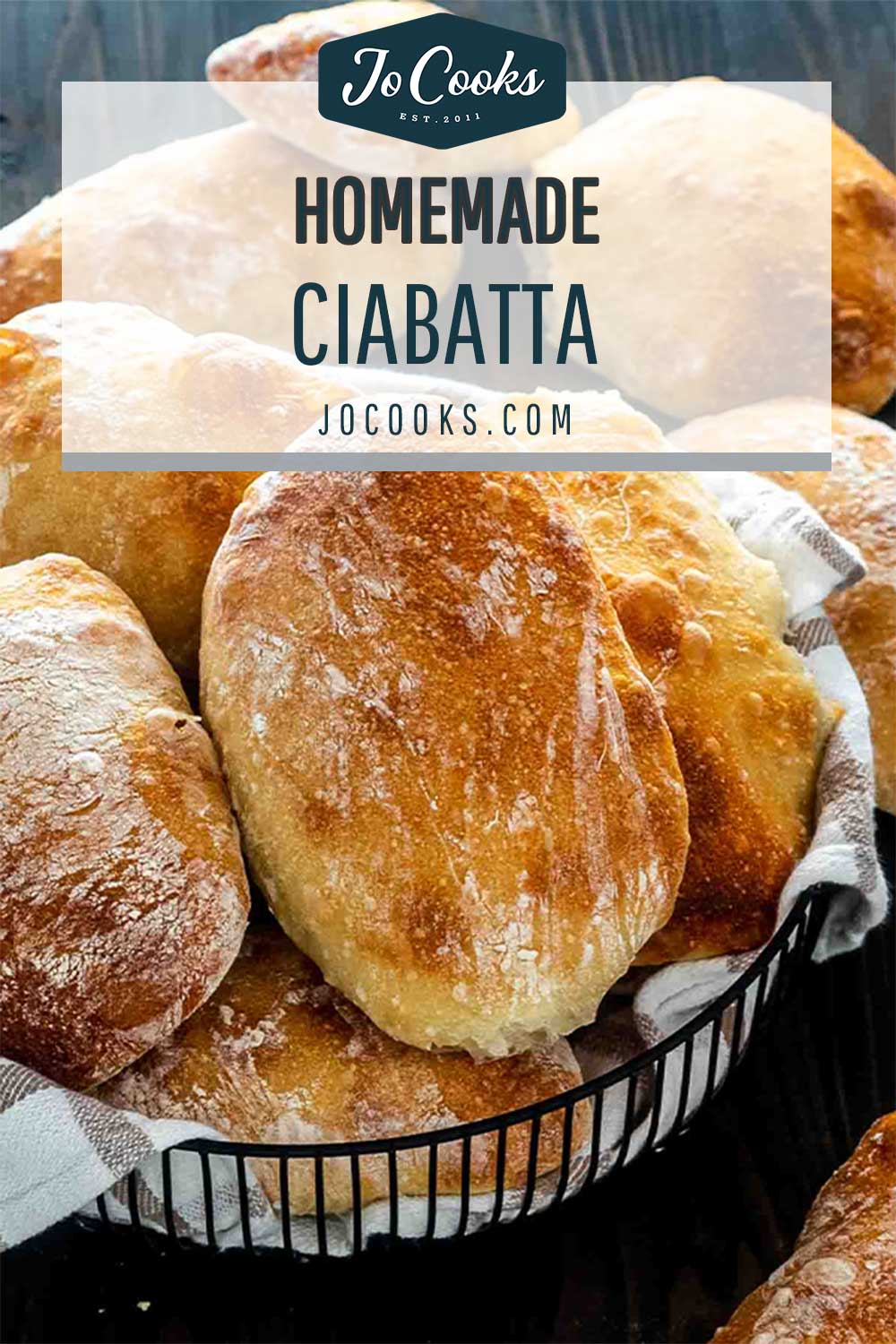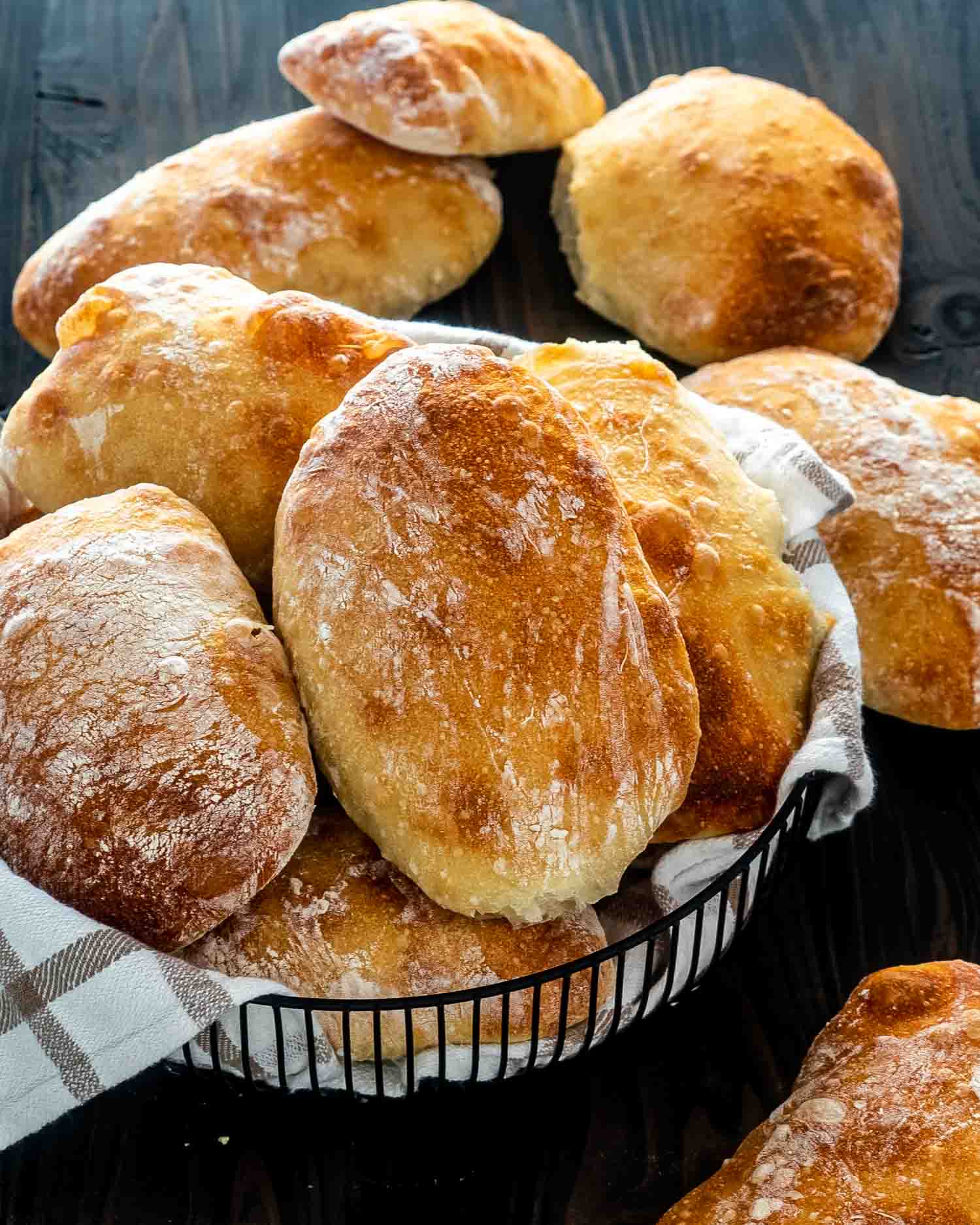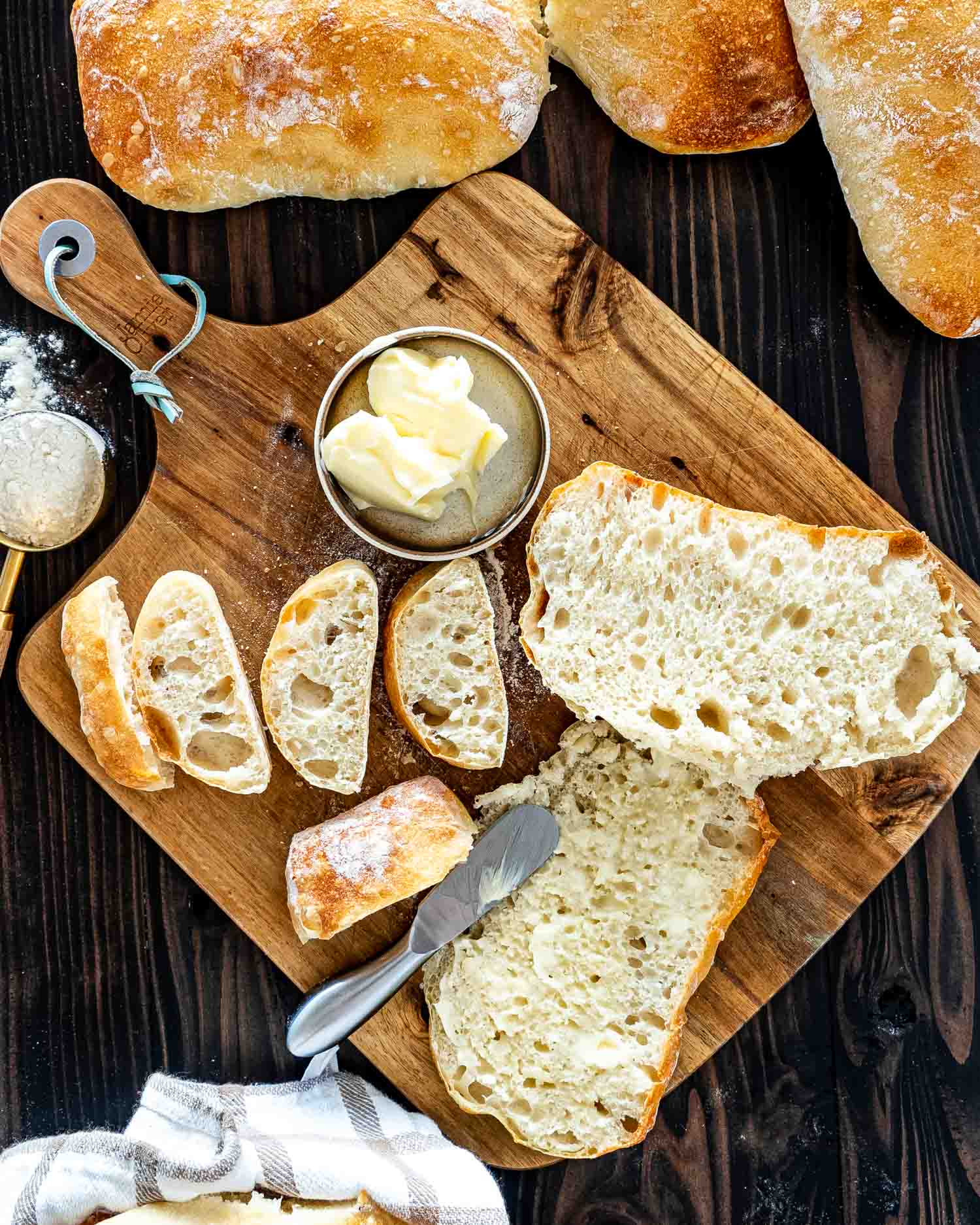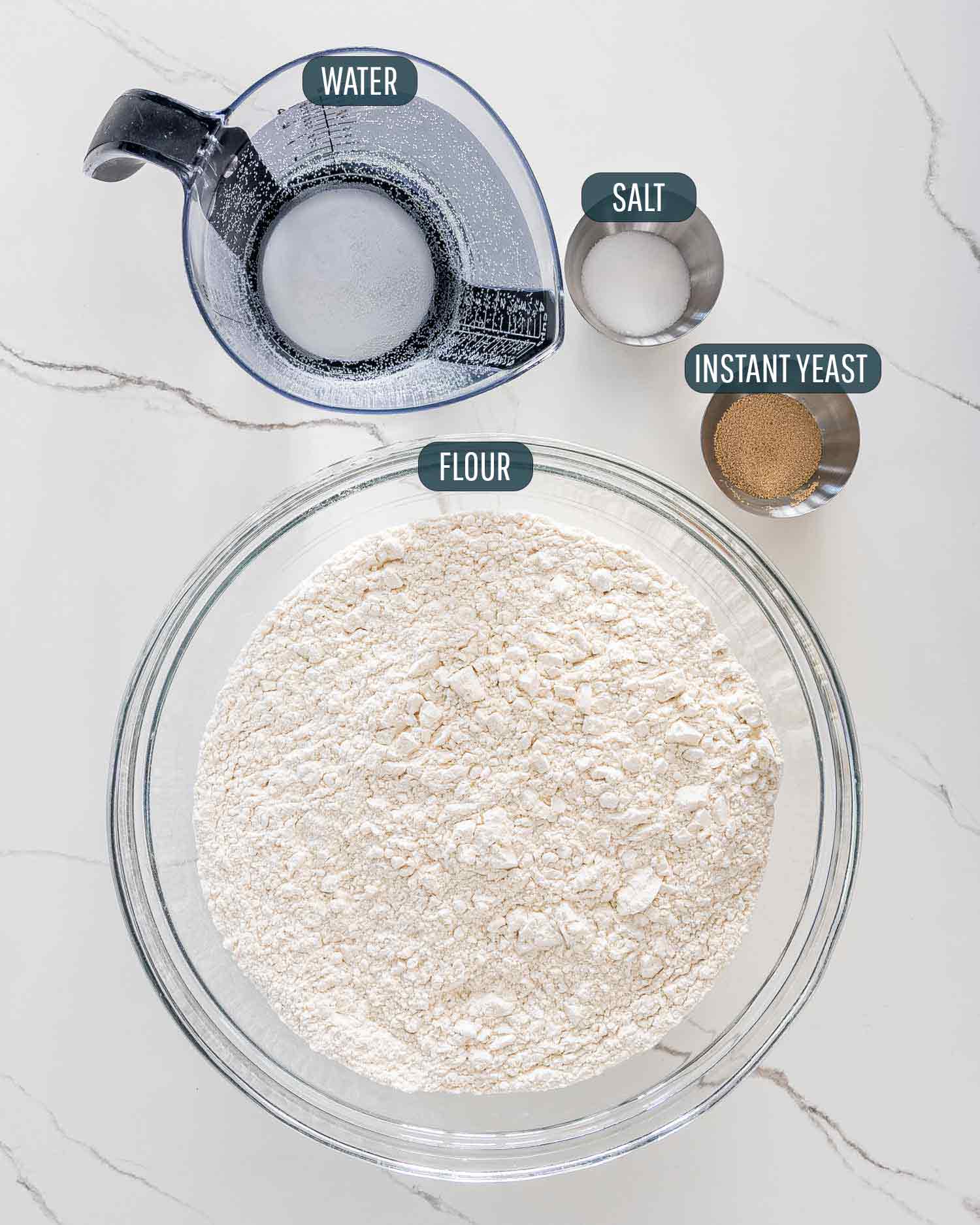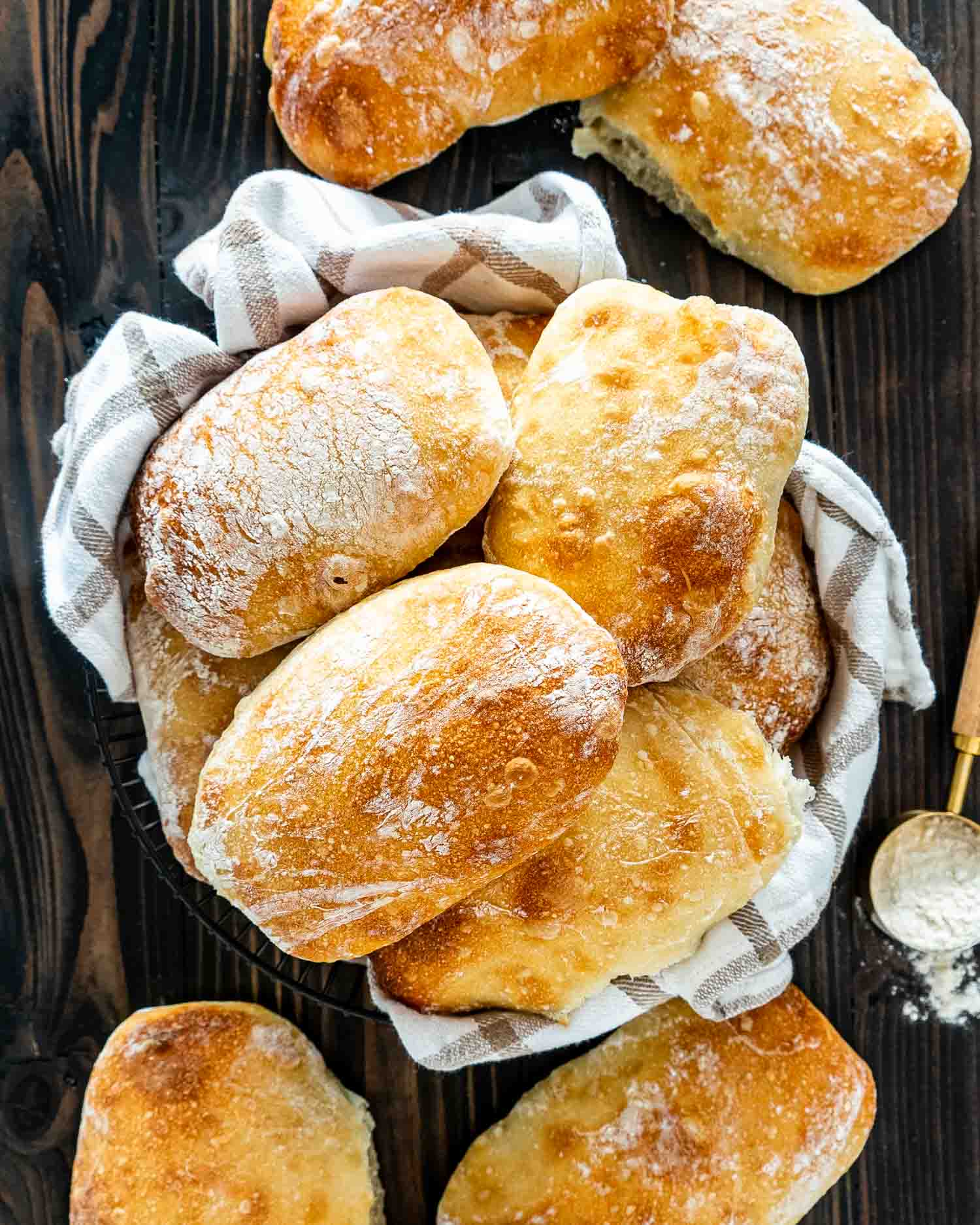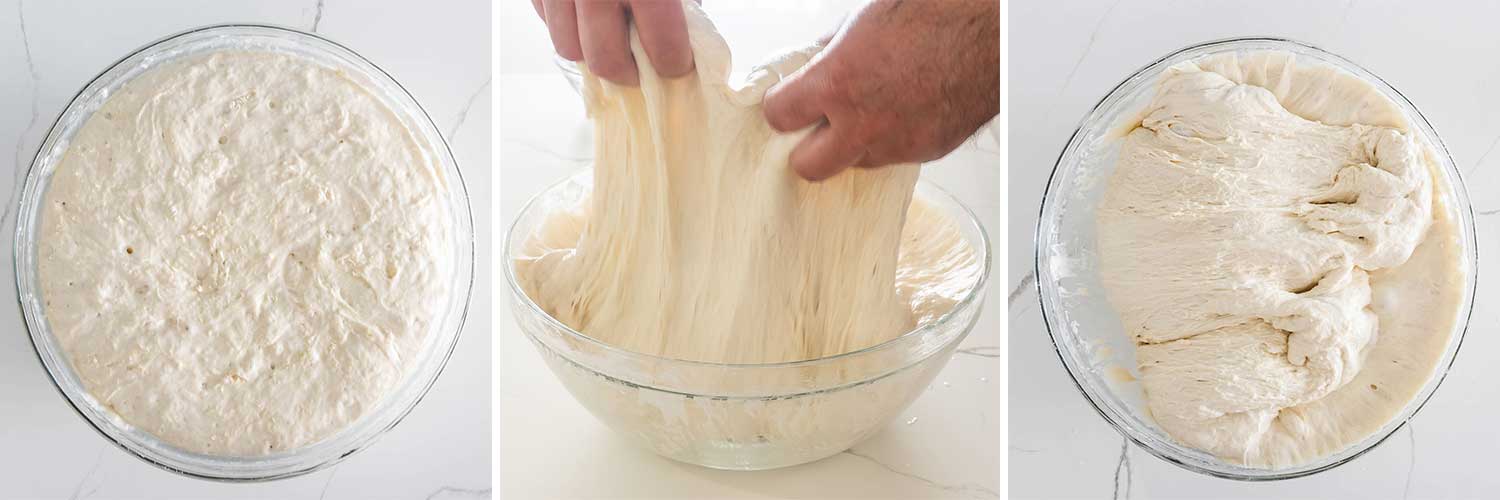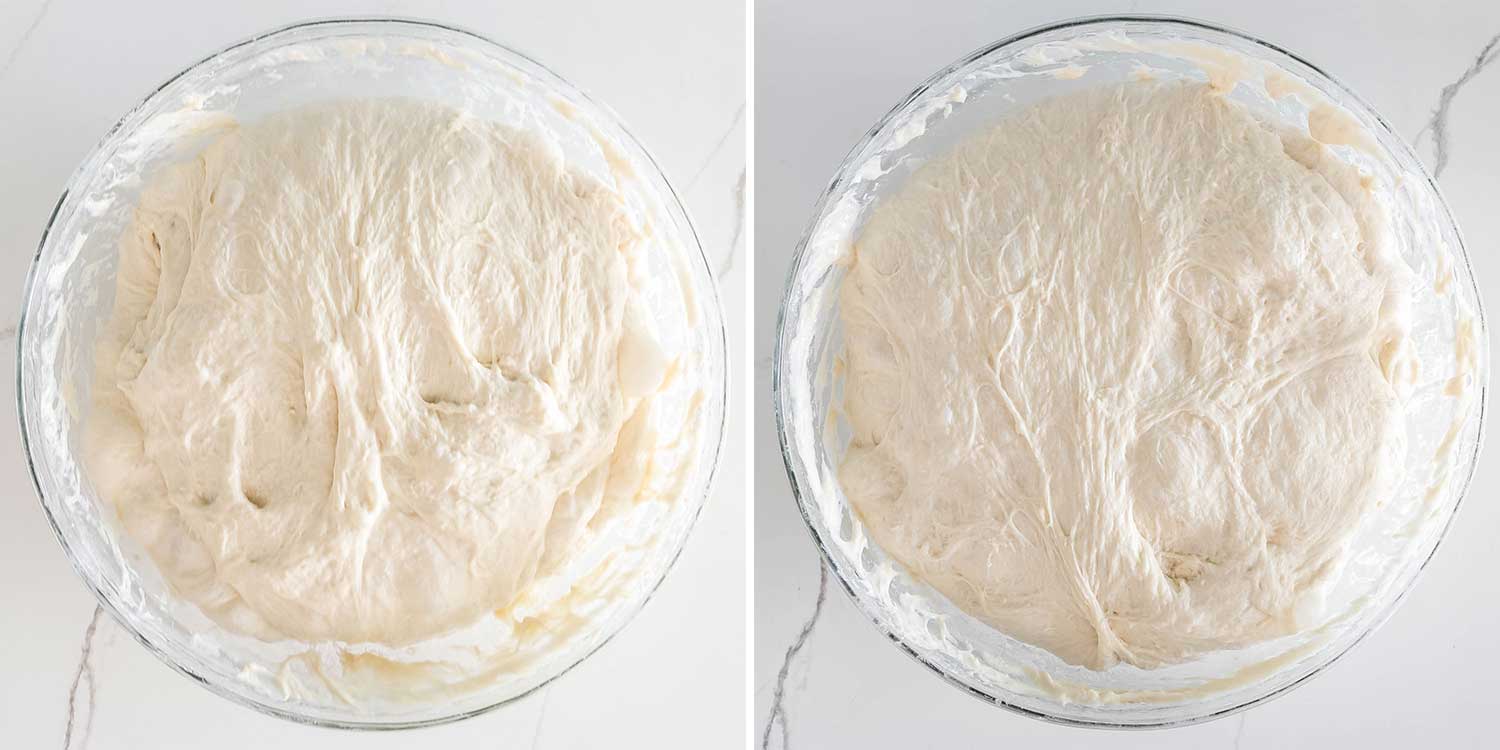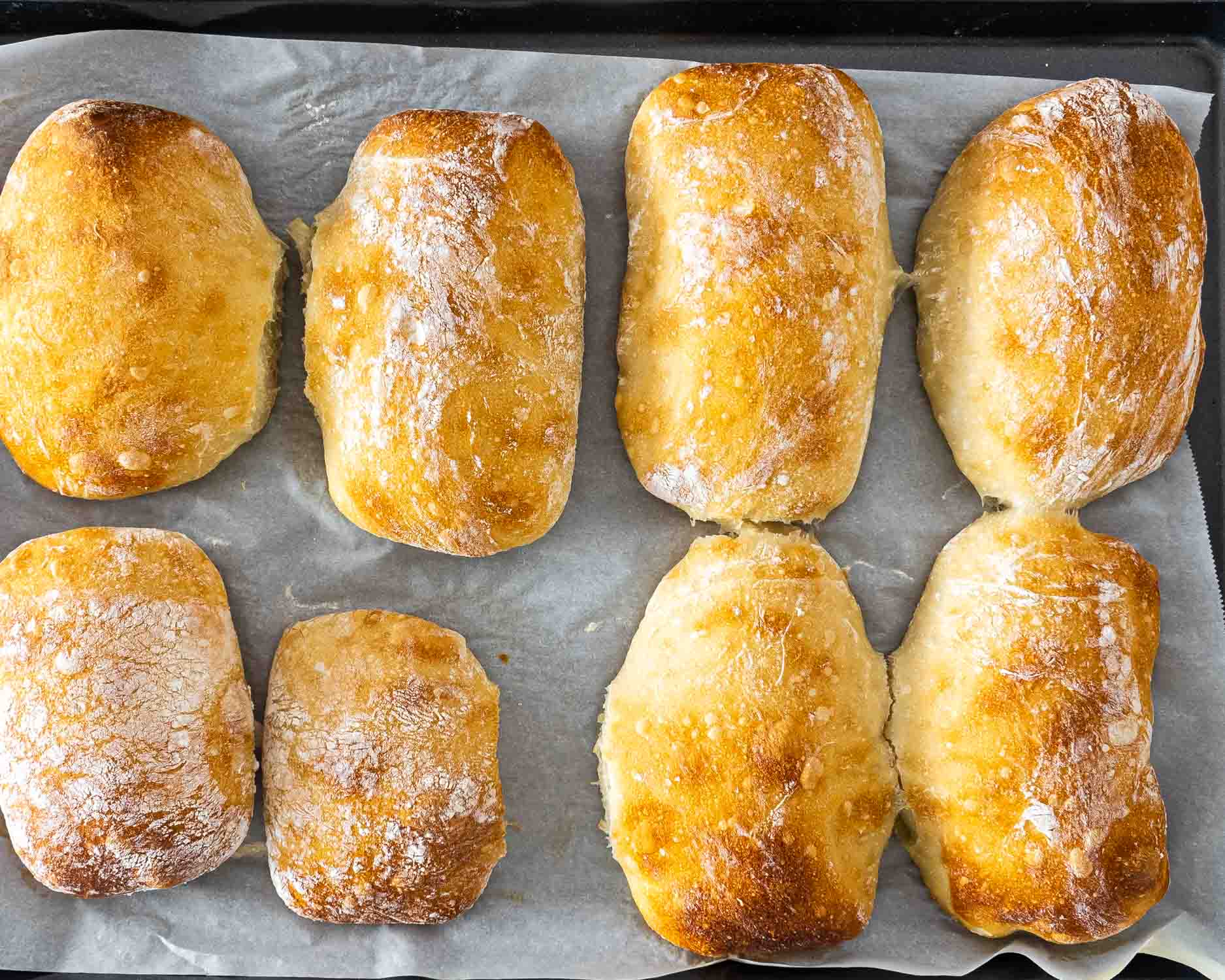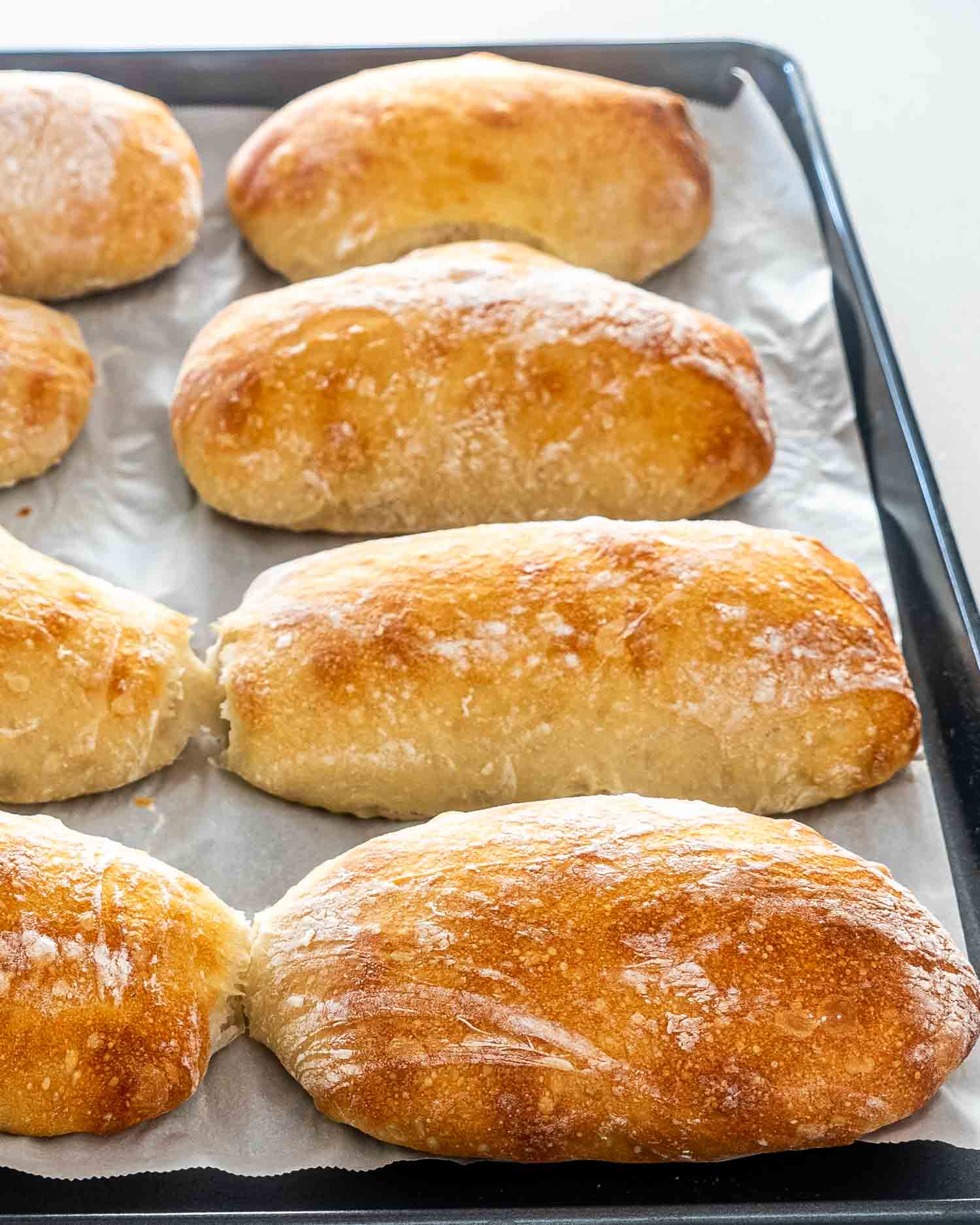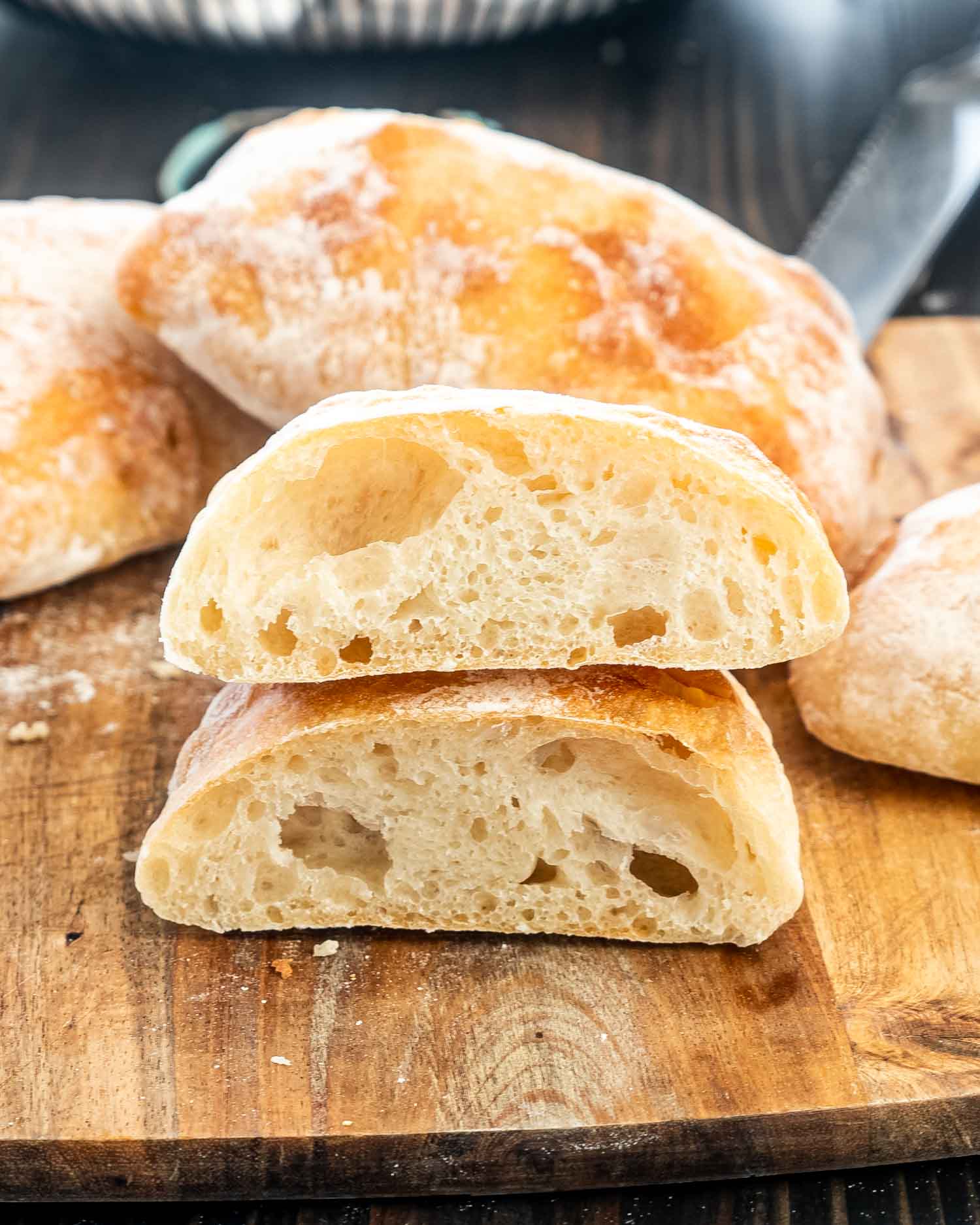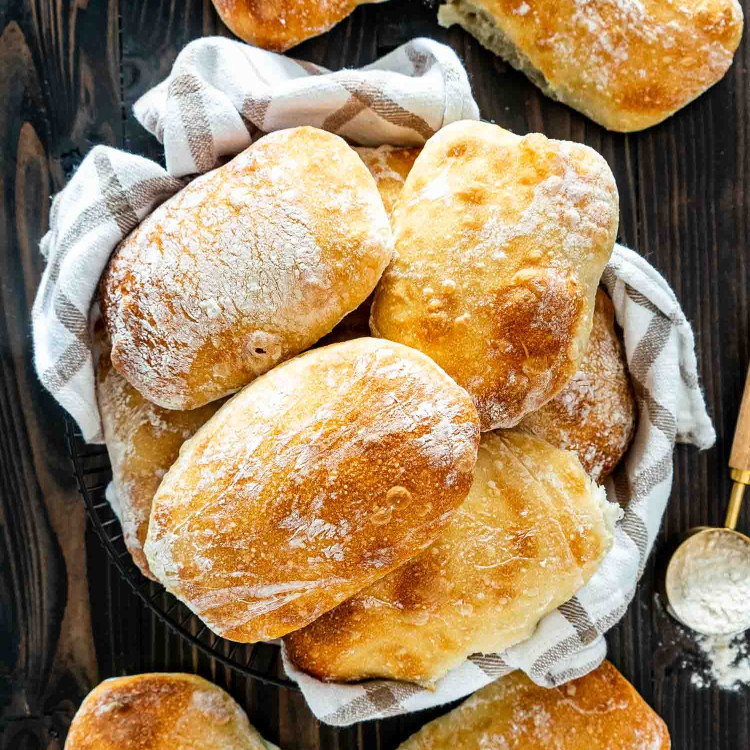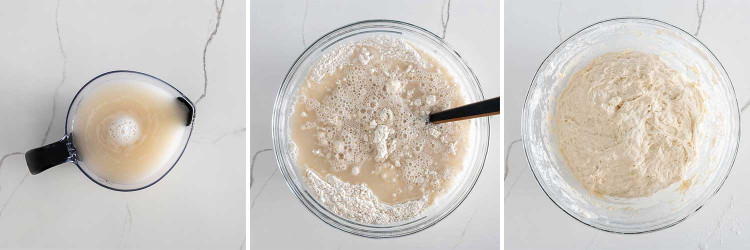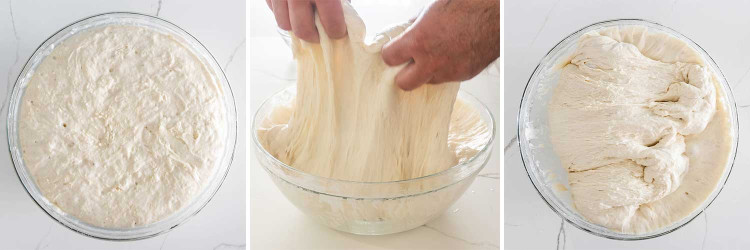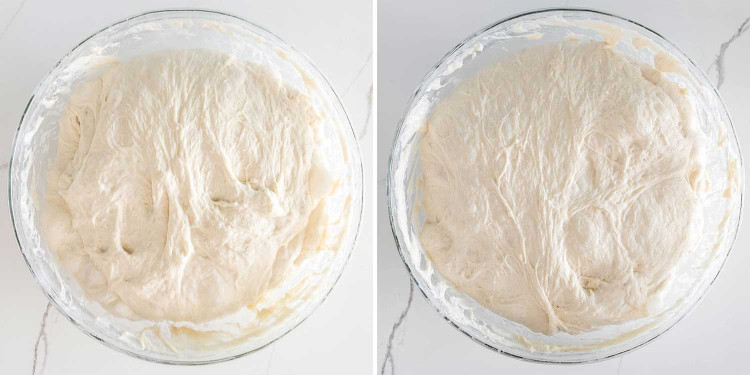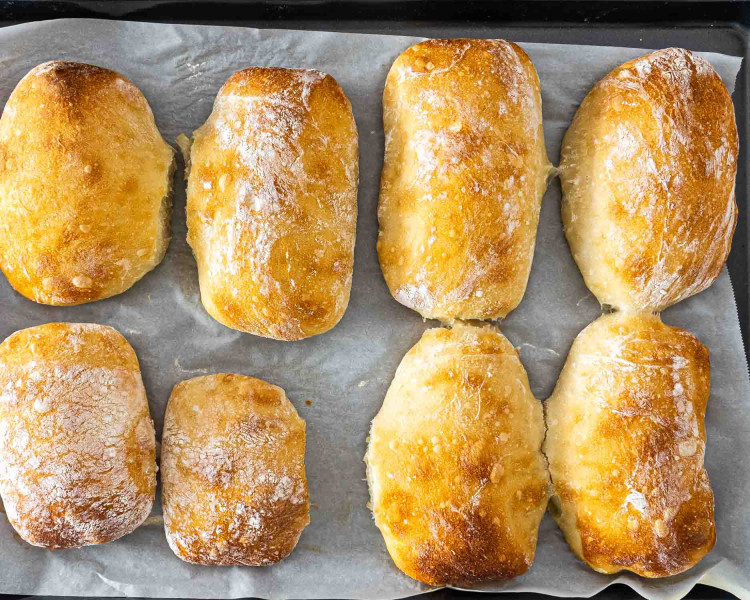Easy Ciabatta Bread Recipe
I love making bread! From handling the sticky dough with my hands to the way it smells when it’s baking in the oven. And of course, there is nothing better than biting into some fresh baked warm crusty bread. Yet, I know a lot of people are afraid of making bread without a bread machine. But as long as your yeast is fresh you’ve really got nothing to worry about. This Ciabatta Bread recipe is especially easy. It’s not like some of my other homemade bread recipes like my Classic Dinner Rolls and Artisan Bread where I suggest using a stand mixer. Nope! Just like my Easy Focaccia, or No Knead Bread it doesn’t require any special equipment. The only tool you need is your hands. So give it a try! Ciabatta is one of my all-time favorite types of sandwich bread. I love the crusty edges of it in the morning with my Bacon Omelette Goat Cheese Breakfast Sandwiches or for lunch with a delicious Steak Sandwich as well as how chewy it is with my saucy Godfather Meatball Sub.
Flour – You just need basic all purpose flour to make this recipe. You can substitute this with bread flour, the only difference is that bread flour has a higher protein content. Salt – A touch of salt is important to help develop the flavor of the dough. Water – Warm room temperature water activates the yeast and brings the dough together. Instant Yeast – A leavening agent that makes the bread rise. Make sure to check the expiration date on your yeast before starting the dough. While I used instant yeast here, you can use active dry yeast, just make sure to activate it first.
The most important part of any bread recipe whether you are using instant yeast or regular yeast is that your yeast is fresh and not expired. Then for this recipe, all you have to do is make a simple dough, wait for it to rise, and then bake it into delicious homemade ciabatta.
Make The Dough
To begin, let’s prepare the yeast! So mix your yeast together well with the warm water (95°F-105°F) in a medium size bowl. For the best results, it’s important that the water is within this temperature range, so you may want to test it with a digital cooking thermometer. You don’t really need to wait for the yeast to activate since we’re using instant yeast, but you do want to mix it well with the water so that it dissolves a bit. Then in a separate large bowl mix the flour and salt together. Now, pour the yeast mixture over the flour and stir everything together using a rubber spatula or wooden spoon to form a shaggy dough.
Let The Dough Rise And Fold
Now, the dough needs time to rise. Cover the bowl with plastic wrap and set it in a warm environment for 30 minutes. For this next part, it’s best to work with wet hands, so place a bowl of water next to you and dip your hands in the water as you work. So after 30 minutes, grab a quarter of the dough from underneath and then lift it up and stretch it until the dough resists. Next, fold it over and onto itself, and then press it down to secure the dough in place. Now, repeat this process 3 more times working around the perimeter of the dough ball. You should have completed a full turn when done. This process is done to develop gluten and create elasticity in the dough.
Let The Dough Rise And Fold Again
For the best texture and flavor, ciabatta needs to rise multiple times and be folded each time after it rises. So cover the bowl and let the dough rise again for another 30 minutes. Then repeat the same folding process as the previous step. Now, do the same rising and folding process with the dough 2 more times for a total of 4 times in all. Each time you’ll notice that the dough is becoming more elastic and easier to stretch, which is what you want. When you are done, the entire process should have taken a little over 2 hours in total.
Preheat The Oven And Prep The Pan
When the dough is finally ready to go, preheat your oven to 450°F (232°C) to get it nice and hot. Now, place a pan full of water on the bottom rack of the oven. This is done to make the ciabatta extra crusty on the outside. Then line 2 large sheet pans with parchment paper.
Form The Ciabatta
You can form the ciabatta many different ways, for example into a loaf, baguettes, or smaller ciabatta rolls. First, gently transfer the dough to a well floured work surface being very careful not to deflate the bubbles. The dough will be pretty sticky at this point, so you should also flour your hands, the top of the dough, and the work surface really well. Now, stretch the dough to form a rectangle that is about 1½ inches thick. Then cut the dough into small rectangles or squares using a well floured bench scraper. In order to keep the dough from sticking, it’s imperative that you flour everything well. You can get anywhere from 16 to 24 ciabatta rolls, depending on their size.
Transfer And Proof One Last Time
Carefully move each rectangle of dough onto the prepared baking sheets using 2 well floured bench scrapers leaving at least 2 inches between each one. Now, allow the ciabatta dough to sit on the counter to proof for 30 minutes. For the best outcome, it’s important that you wait the entire 30 minutes before putting the ciabatta in the oven to bake.
Bake The Ciabatta
Finally, it’s time to bake! Put one of the baking sheets into the hot oven and bake the ciabatta for 10 minutes at 450°F (232°C). Then reduce the temperature to 400°F (204°C) and bake for another 15 to 20 minutes or until the bread is golden brown in color. Then remove the baked ciabatta, turn your oven back up to 450°F (232°C), and repeat the process with the other baking sheet.
Can This Recipe Be Made With Active Dry Yeast?
Yes, of course. However, with active dry yeast once you mix it with the warm water you will need to allow the yeast to sit for 10 minutes undisturbed so that it has time to activate. This must be done before adding it to the flour mixture.
Can I Use My Stand Mixer To Make The Dough?
I don’t suggest using a stand mixer to make this ciabatta recipe. You are going for a dough that is shaggy and not one that needs to be kneaded for 10 minutes. It’s really easy to overdo it with a mixer and this is one bread recipe that comes together really quickly.
How To Store
Ciabatta bread will keep at room temperature or in the fridge for up to 5 days in a container or bag. It also keeps really well in the freezer for up to 3 months in a sealed freezer bag. You can also freeze the bread wrapped tightly in plastic wrap if you don’t have any freezer bags. Then when ready to eat, just remove the ciabatta from the freezer and let it thaw out at room temperature for a few hours.
Other Delicious Bread Recipes To Try
White Bread Recipe Dark Rye Bread Rye Bread No Knead Whole Wheat Bread Potato Bread Amish White Bread Muffuletta Bread Artisan Bread
